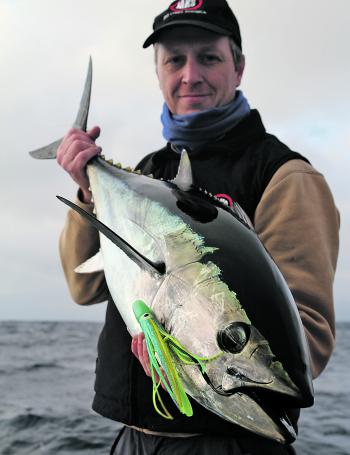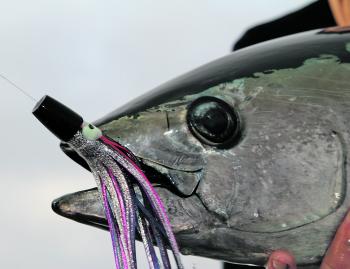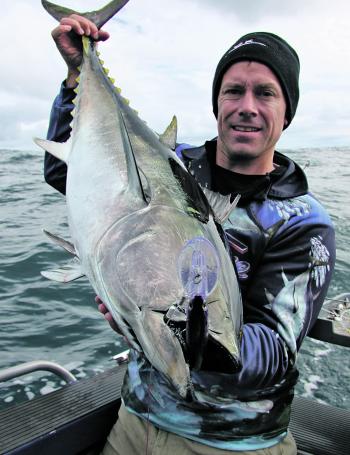March is here and that usually means anglers have the game gear rigged, the boat given a once over for offshore use and an eye on the early season tuna reports around the West Coast of Victoria. If that’s you this season, you are late… months late!
The Victorian and Tasmanian southern bluefin tuna fishery has grown from strength to strength over the last ten years. And at the rate things are accelerating over the past couple of years, who knows where this fishery may end up! The vast majority of Victorians who chase southern bluefin head west, to ports from Apollo Bay across to Portland, and also into southeastern South Australian ports such as Port MacDonnell. Don’t discount turning focus to the east of the state later in the season, as there is a little town named Mallacoota that flies often unnoticed…
Historically, reports have seen some early fish caught around Portland and Port Fairy, often mixed with schools of yellowtail kingfish. The last two years have seen a solid increase in the numbers of these early fish, usually in water less than 40m depth, which can provide sensational fishing opportunities when the fish are switched on.
Chasing these shallow water early season fish that weigh up to a genuine 30kg can be challenging at times, with the fish pushing into the shallow reef areas close to the coast and a lower abundance of their usual food source of small deep water squid, pilchards and sauries can see these fish switch to a variety of other foods.
If you are tempted to troll skirted lures, a popular method is to downsize the usual lures into models that are under 5” in length.
These fish in shallow water can also be targeted well with cast lures. Stickbaits, poppers with a moderate action and soft plastics can prove deadly. Crucial to this fishing is the use of a great quality pair of polarised sunglasses and the ability to read the water and the bird life in the proximity. Blue mirror lenses are ideal for cutting out bright glare in ocean situations. The ideal tell-tale birds in this situation are terns, feeding on the inshore coastal bait and are renowned for following tuna. Watch for them flying erratically, looking down and bobbing into the water.
If you sight fish cruising, they can often be quite shy and scare easily, especially when in water less than 15m depth. Often, the best approach can be to move ahead of the school, cut your motor and cast a stickbait ahead of the moving school. Ideal lures for this are Jack Fin Pelagus, Heru Wahoo, Lurenzo Don Belone, Amegari Leen, CB One Ozma and Strategic Angler Mikros. Quality lures in this situation can prove the difference on a tough bite. Designed and prototyped for this exact style of fishing, they come into a league of their own.
As the season progresses, these shallow water fish don’t draw the same attraction as the ones out wider towards the deep blue. The currents change along the coast and the cold, nutrient-rich water from deep offshore pushes towards the surface and the coastline, bringing with it the ideal food source for southern bluefin tuna. The Portland area is known for being the central hub of a deep water ocean current cycle known as the Bonney Upwelling, created by the southeasterly trade winds that blow in Victoria from November to March.
These winds assist in lifting the nutrient-rich water to the surface from deep offshore and push it parallel to the coastline. This water generally holds masses of krill, providing a superb tuna food source for fish species such as pilchards, cowanyoung, mackerel and sauries and red bait. In addition to these fish species, the waters hold huge numbers of squid, from small squid only a few centimetres long, to fully-grown arrow squid. Squid are a favourite of tuna, and numerous scientific studies show that they make up the vast majority of the southern bluefin diet.
In turn, these areas are where anglers flock. At this time of year, there is a large increase of fishing effort from many anglers. Keeping an eye out for early reports on social media and around the local club, many anglers then hit the road and head west.
The current plays a huge role on choosing the bite locations, with the past several years seeing an ideal situation of great water (with loads of food) being held in relatively close to the coastline (within 10km). The result was great fishing for numbers of tuna and some of massive sizes, with decent numbers of fish over the magical 100kg mark. We can only hope the currents are favourable again. Some key things to look for are the cold temperature edges, or ‘breaks’, along the current line. Also areas where the current slows, eddies or is held will congregate bait and help to attract tuna.
Ensure your boat is up to the offshore waters. These areas can be ruthless and it’s no place for being under prepared. A full suite of safety gear and common sense goes a long way. If you are new to the tuna or game fishing scene, a great way to gain some valuable experience is to either head out on-board with an experienced crew or part with a few dollars to book a charter. There are plenty around and some research will point you towards a quality operation. The quality charter skippers are legitimate professionals in their field and you will be surprised how much information they will share with you if you simply ask questions and show some interest. Don’t simply jump on-board and wait until you get to catch a fish!
Generally speaking, the fish that are regularly and most often caught are school sized fish from 10-25kg, and while you do not need a boat full of 24-37kg premium range game fishing outfits for these fish, you never know when a monster tuna may decide your lure is on the menu.
Medium-sized game outfits around the 15kg line class bracket are great all rounders for many anglers. If you do fancy your chances on a big fish, then don’t muck around and tempt fate on lighter line classes. There is a fraternity of game anglers out there who specifically target big fish on light line, but this takes many years of experience and dedication. A great all round leader weight for your lures is to use 150lb breaking strain monofilament leader. Brands such as Momoi are famous for superb quality and great value.
Tuna fishing in Victoria has a wide variety of approaches that prove effective. Many techniques have been honed and defined, while there are still others that are forging new ground in our waters. We’ll tackle some of these next month in further detail.
The traditional approach of tuna fishing is to troll skirted lures and diving minnows in a spread of up to five outfits. Many anglers have personal preferences of trolling speeds and patterns, but in general, a trolling speed of 5-7 knots is popular. A core element of game fishers that specifically target jumbo tuna will often troll slower than this. Whatever speed you are trolling, make sure it is a speed that your lures are swimming and positioned correctly in your wash.
The ideal location for a ‘swimming’ lure is on the front of the pressure wave behind the boat. This encourages the lure to behave without water and line resistance, allowing the cup of the skirted lure to deliver its designed action. Cupped lures are designed to break the surface, clear some air (termed ‘breathe’) and take it back below the surface. This delivers a bubble trail and wiggle from the lure, encouraging it to swim with action.
Bullet head style skirts are also essential, usually heavy weighted and designed to track straight and below the surface. A deep diving minnow style lure run in the short corner position only 5-10m behind the boat is highly effective, often raising the first bite in a school of fish. Once you hook one fish, it is well worth continuing on for 5-10 seconds as often multiple fish will attack other lures.
The next lure back is termed ‘long corner’ and is positioned on the opposite corner to the deep diver and approximately 5-10m further behind. If you do have outriggers, they are well worth using.
Outriggers provide the ability to widen your spread of lures, allowing the outside lures to swim in clear water outside of the boat wash. Many, many fish can’t resist a lure out here and an added benefit is you can turn in a tighter radius if required. Once again, stagger the distance of these towed lures so your lure spread forms a grouped formation to cover as much water as possible.
The last outfit we need to position is the shotgun, straight behind the motor and back further than all other lures in the spread. Anything over 60m is a common distance for a shotgun lure. There are two schools of thought here, either a small lure that appears isolated and an easy snack, or run a large lure that attracts attention after all the boat wash has settled. Experiment and see what works for you!
Lure size can be a talking point amongst many anglers, but in general, the average length skirted lure trolled by most game fishers is around 6-8” (150-200mm). The use of larger 10” (250mm) and 12” (300mm) lures used to target bluefin tuna in Victoria is growing, and specialist anglers will generally always have a range of sizes in their spread.
Like all fishing tackle, quality lures are not the cheapest but they swim and perform superbly. There are many standout lures, but Jaks Zeus and Barrel Bullet, JB Lures Micro and Small Dingo, Marlin Magic Baby Hard Head, Zuker Feathers and Pakula Lures have long proved extremely productive to have in your tuna spread during the season. Ensure that you have a range of colours, but specifically have a variety of natural baitfish style colours such as evil, red bait and blue dog, along with renowned bright attraction colours such as lumo and grim to accommodate a variety of conditions.
Birds are the best assistance a game angler can have to find tuna. Put simply, if you find the birds and watch their behaviour, they will often point to tuna. You don’t have to turn into David Attenborough and take off to a remote destination for a research trip, but knowing the main species of birds and their behaviour can be a huge help in the vast blue ocean.
Learn to identify terns, gannets and albatross along with some behaviour patterns and you are ahead in leaps and bounds. You won’t always run into a patch of tuna busting the surface and smashing bait until all that is left is an oily slick on the water. Keep an eye out for any erratic flying behaviour, zig-zagging over one area or continually touching down onto the water. And often, one solitary tern can give the game away for the tuna.
If birds are the eyes in the sky, then seals and dolphins are the pointers in the water. Tuna will feed with these species often. They will regularly work together and hold up a bait school for some easy pickings.
When you pair the natural environment with the latest technology, you are on a winner. Using your sounder to find bait schools, take notice of temperature breaks and searching for bottom ledges and reefs or any feature can be a great start to finding tuna. Often, you will also mark the tuna on your sounder, and there is nothing better than marking fish and then counting down until that reel screams off, or even better, you seeing the lure get eaten!
One of the greatest ways to hone techniques and learn how to catch a tuna is to get out there on the water. Pay attention to the weather forecast, always take the wet weather gear (it is Victoria after all!) and don’t be a sheep. Following a pack of other boats only makes things more difficult, especially if they are driving over feeding schools and not around the edges of them. Remember, the aim of the game is to get the lures near the fish! The more boats that are trying to pull a fish from the one area dramatically diminishes your chances. Trust your instincts, and by all means, use the latest reports, sea surface charts and visual cues out there to get amongst them.
Next month, I will take a look at some alternate techniques used by anglers across different parts of the world to tackle bluefin tuna and share some of their hard-earned wisdom.
Reads: 3425
A typical school fish on a 6” pusher.

A natural baitfish colouration skirt and a black head for maximum lure presence was the undoing of this fish.

A well proven diver, with no eyes, paint missing, but still catching!

The author with a jumbo tuna from Portland. Tuna like this require specialised tactics.

Run a diver like this close to the boat for regular success.

Jaks Barrel Bullet bought this great school SBT undone.

Chris Earle taking advantage of some sensational conditions out on the blue.

Multiple hook-ups can result from correct lure spreads.




